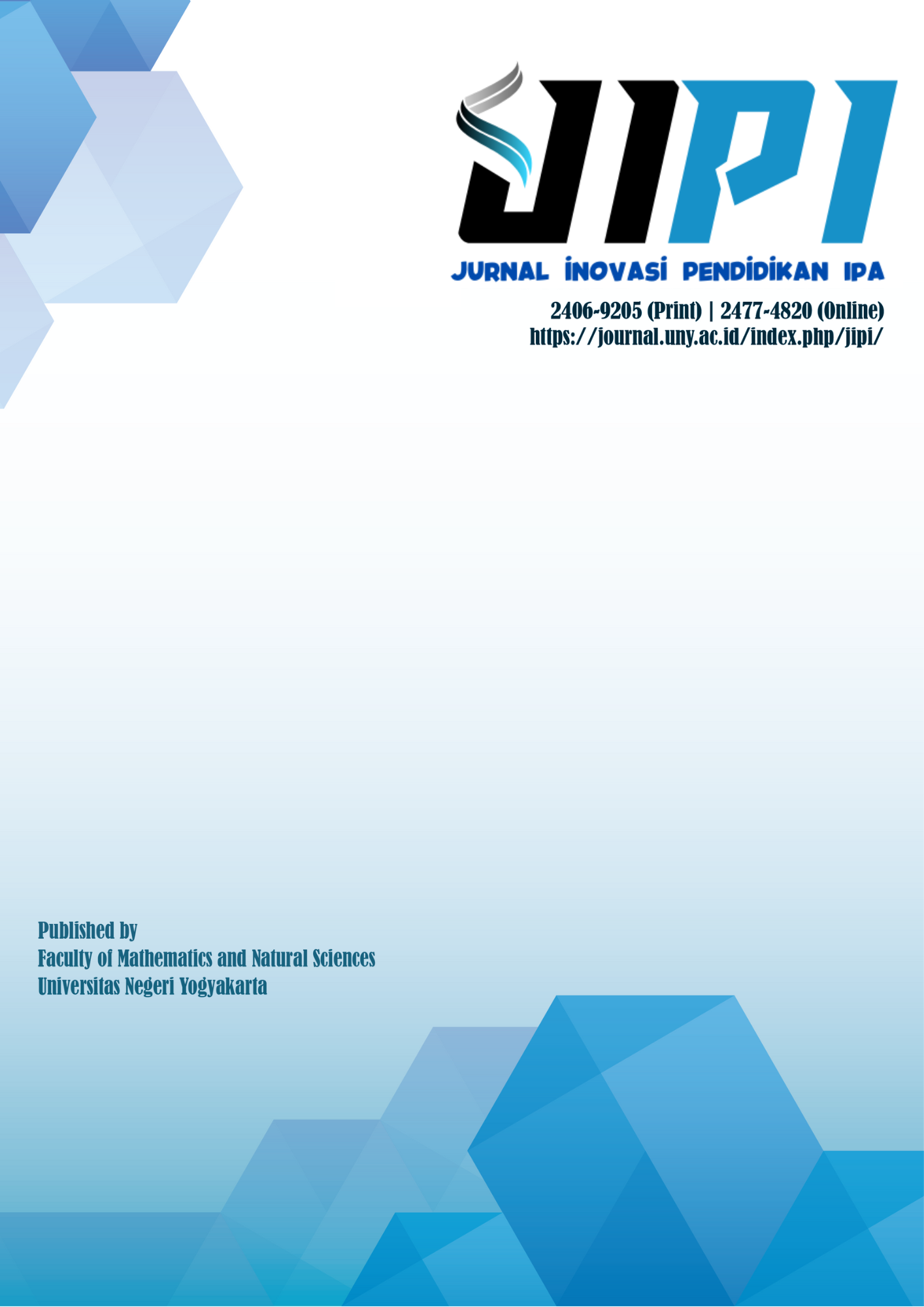PENGEMBANGAN MODEL PEMBELAJARAN MALCOLM'S MODELING UNTUK MENINGKATKAN KETERAMPILAN BERPIKIR KRITIS DAN MOTIVASI BELAJAR SISWA
DOI:
https://doi.org/10.21831/jipi.v1i2.7510Keywords:
Malcom's Modeling Method, keterampilan berpikir kritis, motivasi belajarAbstract
Penelitian ini bertujuan untuk: (1) menghasilkan model pembelajaran fisika berbasis Malcom's Modeling Method yang layak digunakan di sekolah, dan (2) mengetahui apakah model pembelajaran fisika berbasis Malcom's Modeling Method dapat meningkatkan keterampilan berpikir kritis dan motivasi belajar siswa. Penelitian ini termasuk dalam ranah penelitian dan pengembangan (R&D). Prosedur pengembangan mengadaptasi dari prosedur pengembangan yang dikembangkan oleh Borg & Gall dengan langkah-langkah meliputi (1) penelitian dan pengumpulan data, (2) perencanaan, (3) pengembangan bentuk awal produk, (4) uji coba lapangan awal, (5) revisi hasil uji coba lapangan awal, (6) uji coba lapangan, (7) revisi hasil uji coba lapangan dan (8) diseminasi. Subjek uji coba lapangan awal terdiri atas 36 siswa kelas X MIA 6 di SMA N 7 Yogyakarta. Subjek uji coba lapangan pada kelas ekperimen terdiri atas 36 orang siswa kelas X MIA 1 dan pada kelas kontrol terdiri atas 34 orang siswa kelas X MIA 5 di SMA N 7 Yogyakarta. Instrumen pengumpulan data menggunakan soal untuk mengukur keterampilan berpikir kritis, angket untuk mengukur motivasi belajar, angket respon siswa dan lembar observasi keterlaksanaan pembelajaran. Teknik analisis data menggunakan uji MANOVA dengan taraf signifikansi 5%. Hasil penelitian menunjukkan bahwa model Malcom's Modeling Method ditinjau dari sintaks, sistem sosial, prinsip reaksi, sistem pendukung dan dampak instruksional dan pengiring layak digunakan di sekolah dengan kategori sangat baik. Hasil uji MANOVA menunjukkan model Malcom's Modeling Method dapat meningkatkan keterampilan berpikir kritis dan motivasi belajar siswa pada taraf signifikansi 5 %.
Kata Kunci: Malcom's Modeling Method, keterampilan berpikir kritis, motivasi belajar.
DEVELOPING A PHYSICS INSTRUCTION MODEL BASED ON MALCOLM'S MODELING TO IMPROVE CRITICAL THINKING SKILLS AND LEARNING MOTIVATION
Abstract
This research aims to (1) develop a physics instruction model based on Malcolm's modeling method, which is eligible for school and (2) reveal if the physics instruction model based on Malcolm's modeling method can develop the critical thinking skills and learning motivation of students. This research is research and development (R& D) adapting the developmental procedure of Borg and Gall consisting, of (1) research and information collecting, (2) planning, (3) developing preliminary form of product, (4) preliminary field testing, (5) main product revision, (6) main field testing, (7) operasional product revision, and (8) disseminating. The subjects of the preliminary field testing were 36 students of class X MIA 6, SMA N 7 Yogyakarta. The subjects of main field testing were 36 students of class X MIA1 as the experiment class and 34 students of class X MIA 5 as the control class in SMA N 7 Yogyakarta. The data were collected using a test to measure the critical thinking, questionnaires to measure the learning motivation of the students, student response questionnaires and observation sheet. The data were analyzed using MANOVA with the significance level of 5%.The result of this research shows that the physics instruction model based on Malcolm's modeling method in terms of syntax, social system, principles of reaction, support system, instructio-nal and nurturant effect is eligible for the school which is in a very good category according to the validator. The result of MANOVA shows that the model can be used to develop critical thinking skills and learning motivation
Keywords: Malcolm's Modeling Method, critical thinking skills and learning motivationReferences
Alexander, M.E., Commander, N., & Greenberg, D. (2010). Using the four question technique to enhance critical thinking in online discussion. Journal of Online Learning and Teaching, 6, pp.409-413.
Blazer, C. (2010). Twenty strategies to increase student motivation. Research Service, 0907, pp.1-13.
Brophy, J.(2010). Motivating student to learn. New York. Routledge.
Chanchaichaovivat, A., Panijpan, B., & Ruenwongsa, P. (2009). Enhancing conceptual understanding and critical thinking with experiential learning: a case study with biological control. As. J. Food Ag-Ind. 2009, Special Issue, pp.424-443.
Cotrell, S. (2005). Critical thinking skills developing effective analysis and argument. New York: Palgrave Macmillan.
Dye, J., Cheatham, T., Rowell, G.H., et al. (2013). The impact of modeling instruction within the inverted curriculum on student achievement in science. Electronics Journal of Science Education ,17,pp.1-19.
Eggen, P., & Kauchak, D.(2012). Strategi dan model pembelajaran: mengajar konten dan keterampilan berpikir. (Terjemahan Satrio Wahono). Boston: Pearson. (Buku asli diterbitkan tahun 2012)
Ennis, R. H. (2011). The nature of critical thinking: an outline of critical thinking disposition and abilities. Makalah disajikan pada Konferensi Internasional Berpikir ke-6, di MIT USA.
Fahim, M., & Nazari, O. (2012). Practicing action research for enhancing critical thinking. Journal of Science (JOS), 2, pp.84-89.
Hung, C.-M., Hwang, G.J., & Huang, I. (2012). A project-based digital storytelling approach for improving students' learning motivation, problem-solving competence and learning achievement. Educational Technology & Society, 15 (4), pp.368–379.
Jackson, J., Dukerich, L., & Hestenes, D. (2008). Modeling instruction: an effective model for science education. Spring, 17, pp.10-17.
KalelioÄŸlu, F., & Gí¼lbahar, Y. (2014). The effect of instructional techniques on critical thinking and critical thinking dispositions in online discussion. Educational Technology & Society, 17 (1), pp.248–258
Liang, L.L., Fulmer,G.W., & Majerich, D.M., et al. (2012). The effects of a model-based physics curriculum program with a physics first approach: a causal-comparative study. [versi elektronik] Journal of Science and Education Technology, 21,pp.114-124.
Liu, E.Z.F.,& Lin, C.H.(2010). Learning questionnaire (MMLSQ) for grade 10–12 taiwanese students. The Turkish Online Journal of Educational Technology, 9 (2), pp.221-233.
Lunnenberg, .C. (2011). critical thinking and constructivism techniques for improving students achievement. National Forum of Teacher Education Journal, 21(3), pp.1-9.
McGregor, D. (2007). Developing thinking developing learning. New York : Open University Press.
Meltzer, D.E,. & Shaffer, P.S. (2011) Teacher education in physics:research, curriclum & practice.USA: American Physical Society.
Moos, D.C., & Honkomp, B.(2011). Adventure learning: motivating students in a minnesota middle school. JRTE ,43(3), pp.231–254.
Odera, F,Y.(2011). Motivation: The most ignored factor in classroom instruction in kenyan secondary schools. International Journal of Science and Technology , 1(6), pp.283-288.
OECD. (2012). PISA 2012 in result. Diakses pada tanggal 30 Agustus 2014 dari http://www.oecd.org/pisa/keyfindings/pisa-2012-results-overview.pdf
Park, H. (2012). Relationship between motivation and student's activity on educational game. International Journal of Grid and Distributed Computing, 5(1), pp.101-107.
Prince,M., & Felder, R. (2007. The many faces of inductive teaching and learning. Journal of College Science Teaching, 36, pp.14-21
Pritchard, A. (2014). Ways of learning. New York: Routledge.
Rusman (2011). Model-model pembelajaran: mengembangkan profesionalisme pendidik. Jakarta: PT RajaGrafindo Persada.
Schunk, D.H., Pintrinch, P.R., & Meece, J.L. (2010). Motivation in education: theory, research and applications. New Jersey:Pearson Education.
Shihusa, H., & Keraro, F.N.(2009). Using advance organizer to enhance students' motivation in learning biology. Eurasia Journal of Mathematics, Science & Technology Education, 5(4), pp.413-420.
Snyder, L.G., & Snyder, M.J.(2008). Teaching critical thinking and problem solving skills. The Delta Pi Epsilon Journal Volume, L(2), pp.90-99.
Soltanzadeh, L., Hashemi, S.R.N., & Shahi, S. (2013). The effect of active learning on academic achievement motivation in high schools students. Archives of Applied Science Research, 6, pp.127-131
Starkey, L. (2010).Critical thinking skills success in 20 minutes a day. New York: Learning Express.
Sujarwanto. (2014). Kemampuan pemecahan masalah fisika pada modeling instruction pada peserta didik SMA kelas XI. Jurnal Pendidikan IPA Indonesia, 3(1), pp.65-78.
Thomas, T. (2011). Developing first year students critical thinking skills. Asian Social Science,7, pp.26-35.
Thompson, C. (2011). Critical thinking across the curriculum: process over output. International Journal of Humanities and Social Science, 1(9), pp.1-7.
TIMSS & PIRLS. (2011). Overview TIMSS & PIRLS. Diakses pada tanggal 30 Agustus 2014 dari http://timssandpirls.bc.edu/data-release-2011/pdf/Overview-TIMSS-and-PIRLS-2011-Achievement.pdf.
Trilling, B., & Fadel, C.(2009). 21st century skills. USA: Jossey Bass.
Uno, H.B.(2014). Teori Motivasi & Pengukurannya. Jakarta: Bumi Aksara.
Valdez, A.A., Lomoljo, A., & Dumrang, A.P., et.al., (2015) developing critical thinking through activity –based and cooperative learning approach in teaching high school chemistry. International Journal of Social Science and Humanity, 5, pp.139-150.
Wells, M., Hestenes, D., & Swackhamer, G (1995). A modeling method. American Journal of Physics 63(7), pp.606-609.
Wiyanto. (2006). Pengembangan kemampuan merancang kegiatan laboratorium fisika berbasis inkuiri bagi mahasiswa calon guru. Jurnal Pendidikan dan Pengajaran, 39, pp.422-436.
Downloads
Published
How to Cite
Issue
Section
Citation Check
License
The authors submitting a manuscript to this journal agree that, if accepted for publication, copyright publishing of the submission shall be assigned to Jurnal Inovasi Pendidikan IPA (JIPI). However, even though the journal asks for a copyright transfer, the authors retain (or are granted back) significant scholarly rights.
Jurnal Inovasi Pendidikan IPA by http://journal.uny.ac.id/index.php/jipi/index is licensed under a Creative Commons Attribution-ShareAlike 4.0 International License.










